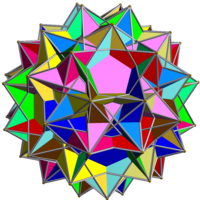Compound of twelve pentagrammic prisms
(Redirected from Great disrhombidodecahedron)
| Compound of twelve pentagrammic prisms | |
|---|---|
 | |
| Rank | 3 |
| Type | Uniform |
| Notation | |
| Bowers style acronym | Giddird |
| Elements | |
| Components | 12 pentagrammic prisms |
| Faces | 60 squares, 24 pentagrams |
| Edges | 60+120 |
| Vertices | 60 |
| Vertex figure | Compound of two isosceles triangles, edge lengths (√5–1)/2, √2, √2 |
| Measures (edge length 1) | |
| Circumradius | |
| Volume | |
| Dihedral angles | 4–5/2: 90° |
| 4–4: 36° | |
| Central density | 24 |
| Number of external pieces | 672 |
| Level of complexity | 42 |
| Related polytopes | |
| Army | Srid, edge length |
| Regiment | Giddird |
| Dual | Compound of twelve pentagrammic tegums |
| Conjugate | Compound of twelve pentagonal prisms |
| Convex core | Rhombic triacontahedron |
| Abstract & topological properties | |
| Flag count | 720 |
| Orientable | Yes |
| Properties | |
| Symmetry | H3, order 120 |
| Convex | No |
| Nature | Tame |
The great disrhombidodecahedron, giddird, or compound of twelve pentagrammic prisms is a uniform polyhedron compound. It consists of 60 squares and 24 pentagrams, with two pentagrams and four squares joining at a vertex.
It can be formed by combining the two chiral forms of the great chirorhombidodecahedron, which results in vertices pairing up and two components joining per vertex.
Its quotient prismatic equivalent is the pentagrammic prismatic dodecadakoorthowedge, which is fourteen-dimensional.
Vertex coordinates[edit | edit source]
The vertices of a great disrhombidodecahedron of edge length 1 are given by all permutations of:
- ,
plus all even permutations of:
- ,
- .
External links[edit | edit source]
- Bowers, Jonathan. "Polyhedron Category C7: Chiral and Doubled Prismatics" (#43).
- Klitzing, Richard. "giddird".
- Wikipedia contributors. "Compound of twelve pentagrammic prisms".





